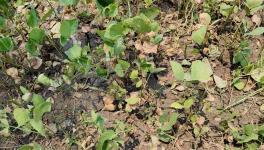Madhya Pradesh: ‘Medical Waste is Dangerous, but we Don’t Know Diseases it can Cause’ -- II

As per the World Health Organisation (WHO), 85% of waste generated by health centres is non-hazardous. Only 15% of biomedical waste includes potentially infectious waste such as HIV, hepatitis-B and C viruses, antibiotics, cytotoxic medicines, halogenated or non-halogenated solvents, heavy metals, oxides, etc. When this 15% hazardous waste gets mixed with other medical waste, it contaminates the entire batch. Therefore, posing significant risks to both people and the environment upon exposure.
There are strict rules for the management of medical waste. However, due to the negligence of relevant stakeholders, harmful biomedical waste (BMW) is on the landfill site, and even on the roadside.

Biomedical Waste Burning in Landfill
The garbage of Narmadapuram, Madhya Pradesh, is collected in the Gwaltoli landfill. The smoke from the garbage burning at the landfill site is a lingering dystopian reality. Through the foul and suffocating smell of smoke, we saw some children collecting plastic from the garbage heap.
Farid Qadri, 30, who lives here, says, "Daily, 40 tonnes of garbage from 33 wards are collected at this site. People here suffer from respiratory issues due to the constant waste burning… yet no action has been taken to address the problem." Apart from general city waste, there is something even more treacherous. Farid tells us, "... dead animals and hospital waste are also dumped here."
Farid’s statement is immediately substantiated. There are injections, vials, and medicines. However, according to the report of the Hoshangabad District Collector, the garbage from all the health centres in the district is being sent to the Common Biomedical Waste Treatment Facility (CBWTF) located in Sehore.

In some villages of the Sehore district of Madhya Pradesh, the BMW is being burned in the open. We have discussed this in detail in our previous article. According to WHO, burning BMW in the open can, under certain circumstances, lead to the emission of dioxins, furans, and particulate matter.
Read Also: Madhya Pradesh: Flaws in Biomedical Waste Management in Rural Areas -- I
According to a report by Health Care Without Harm, “If we make a decision today to release dioxins into the environment, they will stay there not only during our lifetime, but also the lifetime of our children and their children, and their children’s children,”
Dioxins are persistent organic pollutants that accumulate in the environment and our food chain. These are highly toxic and can cause health problems such as cancer, birth defects, changes in the reproductive system, effects on infant development, suppression of the immune system, and reduced fertility in both men and women.
Anand, a sweeper at the primary health centre in Ahmedpur, Sehore district, told these writers, “We bury the 'more dangerous BMW’ in a pit. And the rest of it is burnt.” He said that covers his mouth with a cloth when he ‘disposes’ of the waste this time. He knows that such disposal of BMW is dangerous, but is unaware of the specific diseases he can contract.
For Anand, there are limited options at the primary health centre of Ahmedpur village. There is no vehicle to collect normal garbage from healthcare centres, let alone biomedical waste. Above this, the general public is unaware of the health risks caused by this.
Health Risks of Biomedical Waste
Ravindra Khaiwal, professor of Environmental Health, Department of Community Medicine and School of Public Health, PGIMER, elaborated on the health problems caused by biomedical waste, and said, “The most likely causes are needle stick injuries and cuts from infectious sharps objects. This can lead to hepatitis B, hepatitis C, HIV, and skin infections.”
Health workers, landfill workers, or individuals involved in managing biomedical waste often get injured by syringes contaminated with bodily fluids or infected blood. This contains pathogens that enter the body and cause infection.
Apart from hepatitis and HIV, there are more than 20 blood-borne pathogens that can enter the body through sharp injuries. According to WHO, a person who is injured by a needle used on an infected patient has a 30% risk of getting infected with HBV, 1.8% with HCV, and 0.3% with HIV.
Liquid Waste From Hospitals
According to the Biomedical Waste Management Rules (BMWM) of 2016, liquid waste from hospitals must be separated at the source and treated before releasing into the city sewage line. This liquid biomedical waste is often from places like operation theatres, labour wards, laboratories, canteen, laundry, and toilets in the hospital, and should be separated at source. In the case of Ahmedpur, the work on the sewage line is pending. Dr. KC Mohaniya, the manager at the centre, said, “As per the rules, we treat the liquid waste and put it in a deep tank through a pipe.”
Ravindra Khaiwal said that liquid waste required the most attention in BMW treatment. Several experts these writers spoke with agreed that there was great negligence in this regard from the hospital authorities. Khaiwal said, “There is a [significant] risk of diseases spreading among the general public if the waste from the hospitals mixes with local water bodies like lakes, rivers, etc. through sewage.”
The primary health centre of Ahmedpur is very close to the fields. The pits behind the hospitals, used for the disposal of the BMW, get flooded in the rain. All the hazardous chemicals either seep into the ground or stream directly into the nearby field. The farmers have raised concerns to the hospital, with a limited understanding of the extent of risk.
Disposal of Expired Medicines and Risks
In the Mungavali sub-health centre, a few km before Ahmedpur, expired medicine packers were ‘disposed of’ by burnings in the backyard of the building. Villagers said that the staff had burned the medicines just a few days ago. We saw a similar situation at a landfill site in Narmadapuram. Apart from this, villagers complained that the centre only opens occasionally.
Chandan Khanna, India Project Head of Health Care Without Harm, said, “Dumping pharmaceutical waste, such as expired medicines and equipment in the open harms both our health and the environment. The discharge of this waste into water bodies harms aquatic life. The discharge of antibiotics can also lead to mutations in animals and the development of antimicrobial-resistant bacteria.”
Rajesh Kushwaha, a sanitation worker in Sehore City, said expired medicines were also part of the waste collected from homes, as people throw expired medicines in dustbins along with the general waste. “We don’t separate it at the landfill site,” he said.
Dr. Khaiwal said, “If biomedical waste reaches the landfill site, then there is a risk of harmful substances leaching into the environment. If there is no proper leachate treatment at the landfill site, then this toxic waste can pollute the soil and water.”
As per a report of the Central Pollution Control Board, by the year 2021, only 50% of the total solid waste generated in India will be treated. Hence, most of the solid waste remains at the landfill, polluting the environment forever.
Safety of Health and Sanitation Workers
Dr Khaiwal said as per research, “the management of biomedical waste is worse in primary health centres than in secondary health centres. The main reason for this is a lack of resources and training.”
Sanjulata Bhargava, manager of Sehore District Hospital, has been training health workers to handle biomedical waste in the district for the past seven years. She said, “Apart from training the health workers to segregate waste based on colour-coded dustbins, we also vaccinate them”, adding that the hospital staff was rewarded for efficient biomedical waste management as a performance-based incentive.
Bhargava said medical waste management had improved a lot in the past few years, mainly after the pandemic, from segregation at the hospital level to proper disposal at the CBWTF level. The infection control nurse is vigilant about waste segregation through continuous rounds in every ward, she said. Even the health department demands accountability if something goes wrong. However, she was not quite optimistic about healthcare centres in rural India.
“Monitoring is not done regularly in the villages… We do train the staff there, but we can’t assure that they follow the training,” she said, adding that awareness had increased in the villages.
There are certain rules for health and sanitation workers regarding medical waste management. They are advised to immediately report accidents or incidents about the management of biomedical waste. For example, improper segregation of waste, needle or sharp injury, tearing of BMW bags, spillage of waste, or accidental contact.
Bhargava said, "Health workers report to us in case of a needlestick or sharp object injury. We provide them with necessary medical help and keep them under observation." A record of the complaints or feedback has to be prepared by the Bio-Medical Waste Management Committee and sent to the Pollution Control Committee as an annual report, she added.
Biomedical waste can only be managed and monitored efficiently when there is adequate staff and funds. On several occasions, the funds get delayed by the government. This, in turn, impacts the purchasing of bags for waste segregation.
Bhargava emphasised that as Sehore was the district headquarters and there was sufficient staff of 13–14 persons, the BWM management and monitoring were being done well. In rural areas, a staff of 2-3 individuals manages everything at the healthcare centre.
Even if Aware, Where Should People Complain?
According to Dr Khaiwal, “After the COVID-19 pandemic, seriousness and vigilance have increased around BMW. But, even today, the common people are not that aware of its serious consequences.”
Surprisingly, there is no system in place to complain about the mismanagement of biomedical waste for an ordinary citizen.
Brajesh Sharma, Regional Officer of Madhya Pradesh Control Board (MPPCB), said, “There are 15 divisional offices of the State Pollution Control Board in Madhya Pradesh where complaints can be lodged with the Regional Officer. “Biomedical rules do not oblige any hospital to provide information related to biomedical waste management to the citizens,” he added.
Farid Qadri, a resident of Narmadapuram Gwaltoli, said, “We have given memoranda to the Collectorate and Nagarpalika (the municipal council) about the landfill site power suit and the medical waste in it. But no action has been taken on this matter. On the contrary, we are being intimidated and threatened not to give statements in the media.”
For any system to work properly, public participation is essential. In Indore city, the 311 app is operated by the Municipal Corporation to respond to citizen complaints about their work and quick response.
Arvind Kalyane, Control Room Officer at Indore Municipal Corporation, said, “If a person complains about biomedical waste on this app, then he has to write in the description what type of waste it is. After that, the Municipal Corporation informs the department concerned and ensures proper disposal. We are authorised to issue challans against the relevant parties.”
Deepak Sahu, who manages Indore’s 311 app, said during COVID-19, there was a separate tab for biomedical waste on the app. Then, there were several complaints regarding the same. Now it has been disabled.
Conclusion
As mentioned, the system has improved significantly. However, there is a need for better monitoring and rectifying negligence from both the hospital and CBWTF sides.
In the case of health care centres in rural areas, the connectivity has to be improved promptly, and the deep burial method of disposal has to be eliminated. Apart from hospital staff, the common people have to be made aware of the health problems caused due to the improper disposal of biomedical waste. So, the expired medicines shouldn’t reach the landfill site, among other things.
(Concluded)
The writers are freelance journalists. This two-part series was produced with the support of Health Systems Transformation Platform Fellowship—2023-24.
Get the latest reports & analysis with people's perspective on Protests, movements & deep analytical videos, discussions of the current affairs in your Telegram app. Subscribe to NewsClick's Telegram channel & get Real-Time updates on stories, as they get published on our website.
























